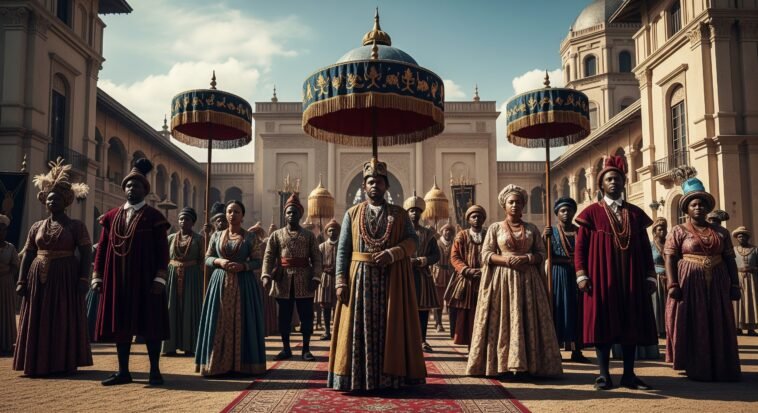
African history isn’t just about colonization—it goes way deeper.
Long before Europe showed up, powerful kingdoms across the continent were already thriving.
They had rich trade routes, impressive governments, and jaw-dropping architecture (think massive stone cities and gold-packed empires).
From West Africa’s gold economies to the stone ruins of Great Zimbabwe, these civilizations weren’t behind—they were ahead in a lot of ways.
Their stories flip the old narrative and show that Africa wasn’t waiting to be “discovered”—it was already doing big things.
The Rise of Africa’s Great Civilizations
Let’s talk about some seriously underrated powerhouses in African history—starting way before pyramids became tourist attractions.
Ta Seti: The first kingdom
Ta Seti was basically the Beyoncé of early kingdoms—came first, set the tone, and doesn’t always get enough credit.
Located in what’s now Sudan, it actually predates ancient Egypt.
Archaeologists believe Ta Seti had early versions of government, culture, and structure that would later influence a bunch of other African empires.
It’s proof that complex societies in Africa were thriving way before the textbooks usually began.
The Kingdom of Kush: Egypt’s rival
Now enter Kush—also in today’s Sudan and often called Nubia.
This wasn’t just Egypt’s neighbor; it was its rival and, at one point, its ruler.
That’s right—Kushite kings (known as the Black Pharaohs) took over Egypt for nearly 100 years and kept things rolling with their own spin.
Kush got rich off gold and controlled key trade routes between central Africa and the Mediterranean.
Their cities, like Kerma and Meroë, had pyramids, temples, and palaces that straight-up matched Egypt in style and scale.
But here’s the cool part—they didn’t just copy Egypt.
They had their own writing system (Meroitic script) and a bold art style that mixed African roots with Egyptian flair.

West African Empires: Masters of Gold and Salt
When people talk about ancient riches, they usually bring up Rome or Persia—but West Africa?
That region was absolutely stacked.
These empires weren’t just wealthy—they shaped trade, education, religion, and politics across the continent. And yes, they made serious gold moves.
The Empire of Mali
From the 1200s to the 1400s, the Mali Empire ran things in West Africa.
It stretched across what’s now Mali, Guinea, Senegal, and more—basically a superstate.
They got rich by controlling gold mines down south and salt deposits up north, plus they dominated the trans-Saharan trade routes.
In short, they knew how to move money.
The architecture? Incredible.
The Great Mosque of Djenné, made of mudbrick, still stands today and looks like something straight out of a fantasy novel.
But Mali’s most famous flex? Mansa Musa.
This dude went viral in the 1300s—his pilgrimage to Mecca was so extravagant, with thousands of people and camels literally dripping in gold, that he crashed Cairo’s economy.
For real. It took years for gold prices to bounce back.
The Songhai Empire
After Mali, Songhai took the spotlight in the 1400s and built the biggest empire in African history.
They ruled from the Niger River and ran a tight ship—complex government systems, a strong military, and full control of key trade hubs.
Gao (the capital) and Timbuktu were the heart of it all.
Timbuktu wasn’t just a trade stop—it was a knowledge hub.
Think Ivy League, but with handwritten manuscripts on astronomy, medicine, law, and philosophy.
Scholars came from all over the Islamic world just to study there.
The Hausa City-States: Commercial Powerhouses
Up in what’s now northern Nigeria, the Hausa city-states were running the show long before most people realize.
According to local tradition, a traveler named Bayajidda showed up in Daura around the 9th century, married into royalty, and his descendants went on to found seven major kingdoms—Daura, Kano, Rano, Katsina, Gobir, Zazzau, and Biram.
These became known as the Hausa Bakwai.
By the 10th to 12th centuries, these cities turned into full-on trade hubs, connecting North and West Africa.
Think of them as the Lagos and Dubai of their time—bustling, wealthy, and deeply connected.
Kano and Katsina especially stood out.
They were famous for handmade textiles, intricate metalwork, and world-class leather goods (seriously, Kano leather was elite).
These weren’t just markets—they were industrial cities with smart urban planning and strong local governments..

Southern African Kingdoms: The Stone Cities
Great Zimbabwe: The Golden Kingdom
Tucked away in southeastern Zimbabwe, not far from Masvingo, are the massive stone ruins of Great Zimbabwe—one of Africa’s most impressive ancient cities.
Built between the 1200s and 1500s, this place wasn’t just big—it covered around 200 acres and stood as the capital of a powerful kingdom.
What makes it wild? The entire city was built without mortar.
Those stone walls, including the famous Great Enclosure with its conical tower, are still standing centuries later.
That’s some serious engineering.
But Great Zimbabwe wasn’t just flexing stonework—it was a major player in global trade.
Archaeologists have found Chinese porcelain, Persian glass, and other goods from across the world, showing the kingdom had trade routes stretching all the way to Asia and the Middle East.
Its main export? Gold—lots of it. And it likely moved through East African coastal cities like Kilwa and Sofala.
By the 1500s, Great Zimbabwe started to fade as power shifted north and west, giving rise to new kingdoms like Mutapa and Khami.
Still, the city remains one of Africa’s boldest reminders that long before colonization, African kingdoms were building global empires—stone by stone.
The Kingdom of Aksum: Gateway to the Ancient World
Long before Ethiopia became known for coffee and marathon legends, it was home to the Kingdom of Aksum—one of the ancient world’s key players.
Sitting in what’s now Ethiopia and Eritrea, Aksum was a trade superpower that connected the Roman Empire to India through the Red Sea.
This wasn’t just a stop on the map.
Aksum minted its own coins (flex), built giant stone obelisks that still stand today, and had a bold, unmistakable architectural style.
It was sophisticated, organized, and way ahead of its time.
And here’s something huge—Aksum was one of the first kingdoms in the world to officially adopt Christianity, a tradition that still shapes Ethiopian identity to this day.
Advanced Political and Social Systems
Let’s clear something up—ancient African kingdoms weren’t just tribes loosely figuring things out.
These were organized, highly functional societies with serious systems in place.
Many of these kingdoms ran large territories with layered governments—think kings, generals, advisors, tax collectors, judges, and skilled workers all playing specific roles.
They had laws, taxes, and even diplomatic systems to keep things running smoothly, sometimes for hundreds of years.
And not every place looked the same.
In some areas, local villages handled things through community consensus.
It wasn’t one-size-fits-all—it was flexible, depending on the people and the region. That’s real governance, not chaos.
Religious and cultural diversity? Also handled. While empires like Mali and Songhai leaned into Islam, others like Aksum followed Christianity, and plenty kept their traditional beliefs alive.
Most of the time, these differences coexisted peacefully—proof that tolerance wasn’t a modern invention.

Trade Networks and Global Connections
Let’s kill the myth that pre-colonial Africa was cut off from the world.
These kingdoms were plugged into global trade networks long before Europe even knew how to navigate a map.
West Africa traded across the Sahara with North Africa and the Middle East—moving gold, salt, and ivory.
East Africa linked up with India, Persia, and even China through the Indian Ocean.
These weren’t small-time deals.
The money from trade funded cities, armies, and massive buildings that still blow archaeologists’ minds today.
And it wasn’t just goods moving—ideas were, too.
New tech, religion, language, and art styles came through these trade routes and blended with local traditions.
African kingdoms weren’t waiting to be “discovered.” They were already in the game—and winning.
Cultural and Intellectual Achievements
Timbuktu wasn’t just a cool name—it was a center of learning.
Its libraries held thousands of handwritten books on everything from medicine to astronomy.
African scholars weren’t just copying—they were innovating.
Art? On another level. The Benin bronzes? Pure fire.
Rock art in the Sahara? Thousands of years old and still telling stories.
These weren’t hobby projects—they were high-skill, high-status cultural work.
And while much of Europe was still figuring out printing presses, African kingdoms kept their history and laws alive through oral tradition.
Griots (oral historians) memorized centuries of knowledge and passed it down like living libraries.
Conclusion
Before colonization, African kingdoms were already killing it—running massive trade networks, building stone cities, creating jaw-dropping art, and running organized governments.
From Kush and Mali to Great Zimbabwe and the Hausa states, these were real power players in world history.
They weren’t waiting to be “civilized”—they were already shaping the global story.
And as more discoveries come to light, the picture only gets clearer: Africa’s past is full of innovation, leadership, and culture that deserves way more spotlight.



